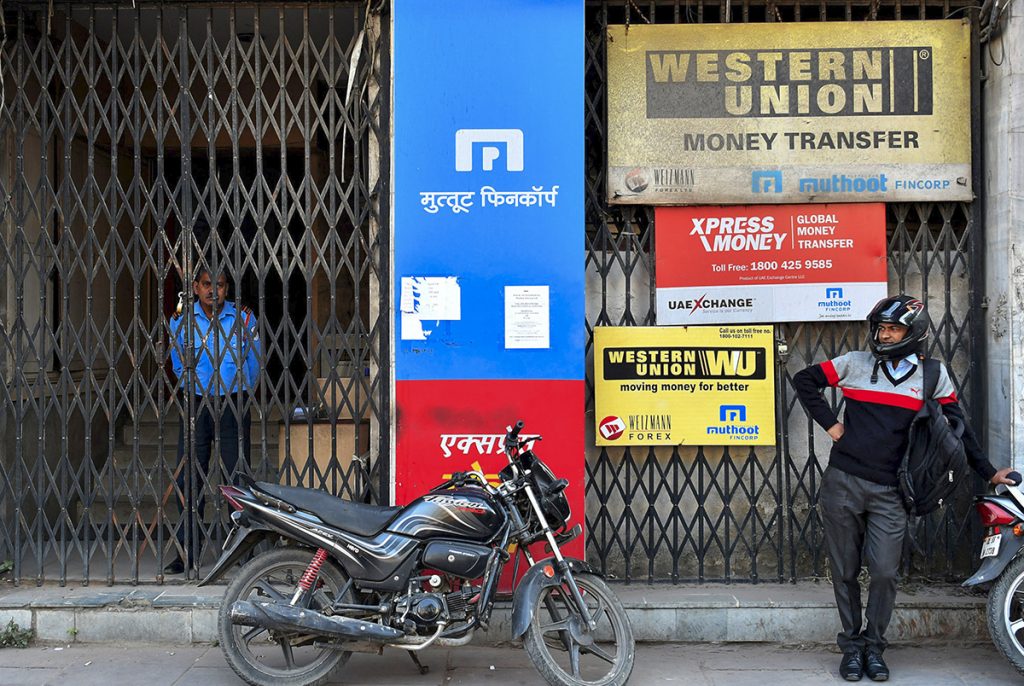Subscriber Benefit
As a subscriber you can listen to articles at work, in the car, or while you work out. Subscribe NowIt had been over three hours, and Raynique Cartwright still hadn’t received her money.
Cartwright, 21, had arrived at the Western Union location in the Bahamas a little before 10 a.m. to pick up funds, but the branch was allowing only two or three people inside per hour, leaving a large crowd outside clamoring to get in.
“Social distancing was almost a non-factor because people started getting rowdy and would gather around the door to see why the line was literally not even moving,” said Cartwright, who eventually made it inside at 1 p.m. “A lot of people left who were ahead of me.”
Cartwright’s plight is playing out at thousands of storefronts around the world that act as agents for Western Union and its rival, MoneyGram. Consumers have flooded social media with tales and images of lengthy lines and boisterous crowds seeking to pick up funds sent by friends and family abroad. One person in the Queens borough of New York photographed a line that stretched the length of the city block. At a location inside a gas station in Jamaica, dozens clustered around the pumps as they waited to access their funds.
Migrant workers are major customers of the money-transfer companies because they often have family abroad and are excluded from traditional banking services, where those who are better off financially have flocked to computers and phones for their transactions.
Roughly a billion people worldwide either send or receive remittances. For the recipients, the money is a lifeline that can account for more than half their income, even though senders often wire them just 15% of what they earn, according to data compiled by the United Nations.
Because it often caters to under-banked consumers, the business has remained stubbornly in the physical world, with MoneyGram and Western Union operating almost a million locations through their agent networks. Customers typically like picking up cash in person because it’s currency they can spend immediately.
That’s meant the companies have struggled amid the global lockdown instituted to stem the spread of the deadly coronavirus. It’s left some outlets understaffed and some branches, such as those inside retail stores, either closed entirely or forced to contend with shorter hours.
About 40% of MoneyGram’s locations are shut, and many “have some sort of disruption to operating hours or normal flows,” CEO Alex Holmes said in an interview.
Brad Windbigler, Western Union’s head of treasury and investor relations, said the company is “doing everything we can” to stay open. “It’s a privileged space for us to be in to serve that market,” Windbigler said in an interview.
Remittances to low- and middle-income countries have steadily grown in importance in recent years, reaching a record $554 billion in 2019, according to data compiled by the World Bank. Last year was also the first time remittances surpassed foreign direct investment in those countries.
Then the coronavirus hit, leaving many customers out of work or stuck at home, unable to continue sending money abroad. The World Bank expects remittances globally to drop 20% this year, the sharpest decline in recent history.
“It will take some time for us to get through the unemployment,” said Michael Brown, CEO of Euronet Worldwide Inc., which operates the Ria money-transfer business. “As people regain employment, their first thought will be to continue to be with their families and their family’s well-being.”
The World Bank anticipates countries in Europe and Central Asia, where the Kyrgyz Republic and Tajikistan rely on remittances for almost 30% of gross domestic product, will see a 28% decline in remittances, the steepest drop globally.
Countries in East Asia and the Pacific—the region that receives the largest amount of remittances on a dollar basis—could see such flows slide 13%. The roughly $35 billion the Philippines receives in remittances each year accounts for 10% of gross domestic product, according to the World Bank.
The question executives face now is whether demand for their services will rebound as shelter-in-place orders are lifted, or if lingering unemployment will leave consumers unable to send money back home.•
Please enable JavaScript to view this content.

